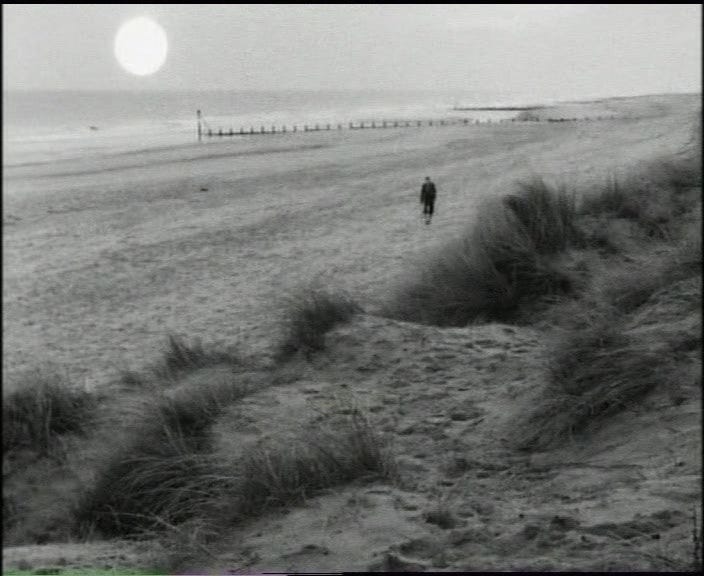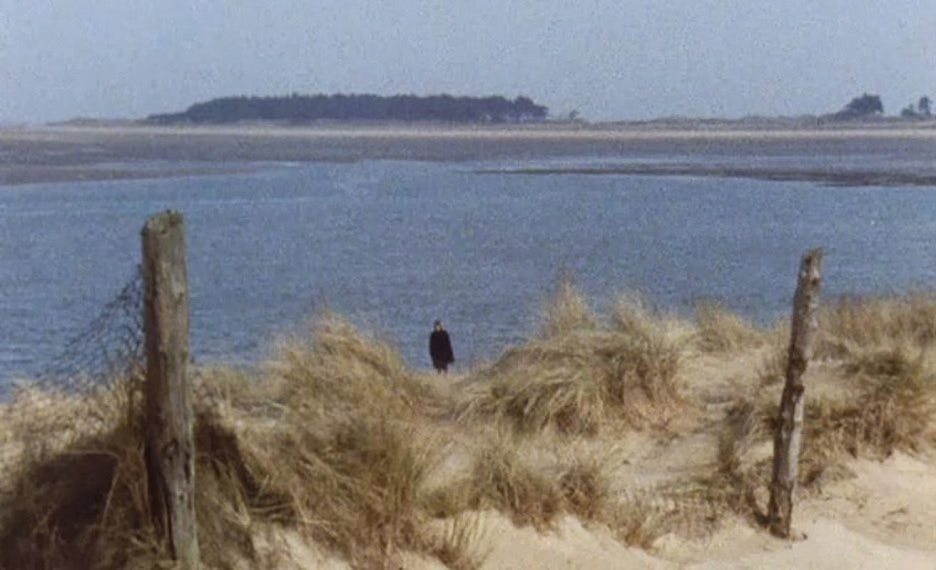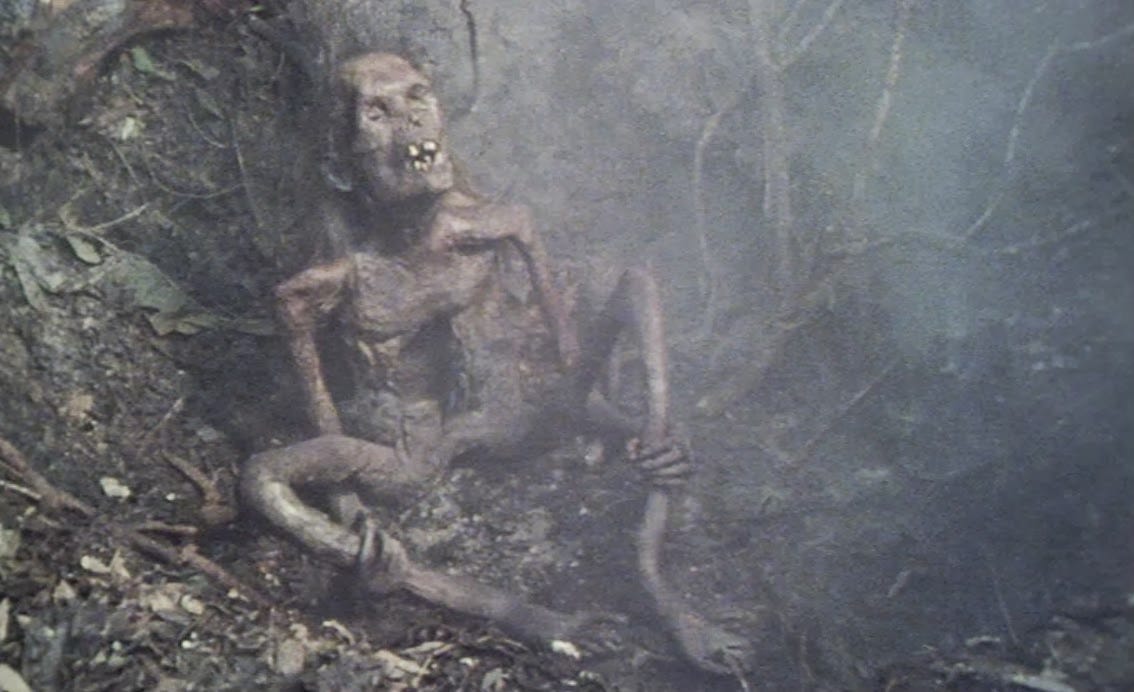The Haunting Allure of BBC's Ghost Stories for Christmas
Why do they matter for the modern climate discourse?
Ghost stories during Christmas might seem anathema to some, but the BBC adaptations of M. R. James' tales from the late 60s to the mid-70s have cemented themselves as seasonal classics. For the last two years the British Film Institute have released pristine remasters of these films. The BBC themselves have attempted to ape the 70s success with recent adaptations on the works of M. R. James and Arthur Conan Doyle, although, arguably, without the same eeriness inherent in the originals. These earlier adaptations uniquely capture the weird interplay between the natural world and human existence, often unsettling our anthropocentric worldview.
Nature as an Existential Threat
The BBC adaptations of M. R. James' stories foreground the natural world as a central, often antagonistic force. Out of the 36 stories James penned, five were adapted for the BBC's A Ghost Story for Christmas, with four highlighting nature's existential threat. These adaptations depict, vividly, nature not as a mere backdrop but as an active agent, challenging human dominance and stability. The primary adapter, Lawrence Gordon Clarke, has made no secret in interviews of being especially interested in James’ use of the landscape, and it is evident that his choice of stories to adapt, given the breadth on offer, is selective and tilted towards the ecological.
Eerie Anglia
It is East Anglia, specifically, with its shorelines and landscapes, that serves as a critical setting in these stories. The films' locations, while set in Suffolk, were often shot in Norfolk, infusing the narratives with a sense of place that is both expansive and claustrophobic. This is the stomping ground, and I use the term literally, of W. G. Sebald, who novelizes a walking tour along the coastline in The Rings of Saturn. Or Henry James, who wrote of Dunwich, which has largely crumbled into the sea, as ‘not even the ghost of its dead self’.1 This pre-empts the ontological and hauntological effects of this coastline highlighted by the BBC films. More recently Mark Fisher and Justin Barton documented a similar journey inland, from Felixstowe, where Whistle and I’ll Come to You (1968) is set, to Woodbridge and the home of the Saxon burial ground on the Sutton Hoo estate. In their audio essay On Vanishing Land, Fisher and Barton discuss watching these same adaptations of M. R. James with the sound off and Brian Eno’s ambient album On Land playing instead. They note ‘the abstract spaces of sky and land, with a single figure in the middle distance, an incursion of the unknown. The music evokes Suffolk spaces of calm detachment, detachment on the edge of delirium.’2
Delirium: a transient condition involving mental collapse including disorientation, hallucination and confusion. The inability to recognise or orient oneself. For Fisher, these Suffolk locales, so cut off from urban life, threaten to undo the hegemonic orders of anthropocentrism.
What Fisher and Barton miss by replacing the audio with an Eno LP is the foley artistry of these films. In Whistle and I’ll Come to You, the noises of the wind crescendo as the title card appears, collapsing the wind into the whistle, and providing agency to this natural phenomenon.
The films work to draw out that thread left by James and bring the landscape to the foreground. You can see this literally in some frames, as the figures (one a ghost and one a “living being” are framed in the composition of the shot as dwarfed by the encompassing shore and heathland.
Dehumanizing the Anthropocentric
The adaptations often present nature as a force that dehumanizes and destabilizes established human orders. For instance, in The Stalls of Barchester (1971) and The Ash Tree (1975), natural elements like trees become symbols of retribution against human desecration and authority. The cursed oak in The Stalls of Barchester and the monstrous progeny in The Ash Tree illustrate nature's rebellion against human exploitation and patriarchal structures.
The Stalls of Barchester centres on a cursed cathedral stall, made from the oak of a Norse hanging tree. The curse reads that any murderer who touches the wood will die, which is, as you can probably guess, exactly what occurs with this Archdeacon.
In this instance, the re-appropriation of an oak tree leads to the death of figures of authority, as it is only touched by the Archdeacons of the cathedral, who are also shown to be murderers themselves.
Similarly, in The Ash Tree, a nobleman who has newly inherited Castringham Hall is told that the large Ash on the grounds, with its branches brushing against the windows of his bedroom, ‘drains all the goodness’ and threatens the foundations of stately homes. He intends to cut it down, but before he can do so a progeny of spider-babies nesting in the branches kill him, as they did his ancestor who executed a woman for witchcraft. The tree is burnt down and the woman’s corpse, now embedded with the roots of the tree, is uprooted.
Both films present a unique relationship between the arboreal and human, as the former lies in contention with anthropocentric ideals and arbitrary structures of authority, but is nevertheless, directly tied to us.
Feminism and Ecological Revenge
The Ash Tree particularly intertwines themes of feminism and nature, portraying the witch character, Mistress Mothersole, as a figure of ecological and feminist resistance. Tellingly, in James’ original, she is an old woman with no indication of attraction between herself and the Lord of the manor. Yet, in the film, she is played by Barbara Ewing, an actor with credentials as a horror sex icon from Hammer’s Dracula films. This emphasises the overlap between metaphors of fertility and rape of the landscape and women.
The use of Ewing elaborates the film’s preoccupation with progeny, lineage, and reproduction as mass production through the role of women in the aristocratic system as baby-makers, via the character of Sir Richard’s fiancée. This is nicely subverted by the witch’s mutant offspring stemming from the tree that kills the noblemen.
Rationalism Versus Nature
H. P. Lovecraft opens his story The Call of Cthulhu by opining that, “The most merciful thing in the world is the inability of the human mind to correlate all its contents”.3
For the American critic Mark McGurl, Lovecraft’s sentiment and examples from genre fiction demonstrate the complexities of ecological scale through the ‘representation of the inhumanly large and long’.4 By scale, I am primarily referring to the work by the ecological theorist Timothy Clark, which addresses the difficulty of correlating the relation between mass events and phenomena with the comparatively microscopic anthropocentric perspective.
For instance, Clark notes that one issue of discussing the current climate crisis is that there is often a rhetorical compulsion to reframe the mass event in terms of the experience of an individual. He observes in one example how, as a result, ‘a sentence about the possible collapse of civilization can end, no less solemnly, with the injunction never to fill the kettle more than necessary when making tea’.5
Detouring from McGurl, I believe that M. R. James’ more earthbound stories, and these adaptations specifically, are more appropriate texts to think through the inherent disharmony in anthropocentrism and humanity’s relationship with the natural world.
In relation to this issue of scale is the lichen. In their introduction to the ghost section of Arts of Living on a Damaged Planet, Gan, Tsing, Swanson and Bubandt argue that ‘lichens are more-than-ghosts of the past’.6
This is indicative of how Jonathan Miller stresses the ecological in his adaptation of “Oh, Whistle, and I’ll Come to You, My Lad”. The original text features a young upstart academic visiting the Suffolk coastal town of Burnstowe, a feeble pseudonym for the real Felixstowe, which many of you will know is now the largest container port in the United Kingdom. When a colleague hears of this trip, he requests that Parkin seek out an old, ruined Templar preceptory to see whether it is worth an archaeological expedition. Here Parkins finds an old whistle that, once blown, calls a revenant
In Miller’s adaptation, Parkin – without the “s” – is an old rationalist, played by a bumbling Michael Hordern. Mark Fisher describes the characterisation as a “crumbling logical positivist, his mind eroding as surely as the threatened East Anglian coastline, only far more quickly”.7 And Parkin is not performing a friendly reconnaissance on a ruin, but rather ambling through the bristling hedgerow and thickets, finding himself amongst an overgrown graveyard, in which lichen clings to the decaying gravestones. There he finds a bone carved into a whistle.
Lichens are illustrative of a natural world that is indiscriminate as to what or who it absorbs into its network, whether it is the bark of a tree or the commemorative slab of a grave, with its name and date worn away by the sea winds.
The story ends with Parkin seeing the ghost in his bedroom, and having to confront the fact that there are things he cannot comprehend and that his rationalist philosophy does not allow. The final shots are of him moaning, sucking his thumb, and staring dumbly into the middle distance. However, what is notable about Miller’s adaptation is that Hordern’s characterisation of Parkin is feeble-minded from the beginning, trundling around the landscape and his lodgings with inelegance and muttering to himself.
Moreover, the landscape is threatening only when it is absent of indicators of human presence, such as the hotel. Parkin is a character that is protected by human interiority. His social position and the system of the academic setting in his university town provide him security. However, this is absent out in the dunes, and he cannot escape the practicalities of his eroding mind any longer.
The lichen on the tombstones are indicators of the great levelling capacity of Nature. They are, as Anne Pringle writes, transported through the mining and utilisation of the rocks and cliffs, becoming ever-present reminders that however we might try to transform the world around us to meet our supposed needs, such as erecting monuments for the dead, they are rock still, with living communities of bacterial assemblages.8
By placing the finding of the cursed whistle into this framework, Miller’s film parallels Parkin’s certain breakdown with the erosion of the stones. Both are mortal remnants of a doomed effort to elevate the human above all else. For Parkin, it is through his devotion to academic pursuits and rambles which are pedantic, patronising, and littered with tautologies. For the graveyard, the fetishisation of the dead is arbitrary, as the name, comparative to the aeons of the rocks, is swiftly erased. Even the ghost eschews romantic ideals of the spirit and unique soul of the human, as we learn nearly nothing about it, and it never manifests in a human form.
Conclusion
These BBC adaptations of M.R. James' ghost stories masterfully destabilize human-centred perspectives, using the natural world as a haunting, powerful force. They remind us of the inherent disharmony in our anthropocentric worldview, urging a re-evaluation of our relationship with nature. Through eerie soundscapes, evocative landscapes, and narratives that challenge human authority, these films remain timeless, hauntingly beautiful tributes to the power of nature and the supernatural.
Henry James, ‘Old Suffolk’, in English Hours (Urbana, Illinois: Project Gutenberg).
Justin Barton and Mark Fisher, On Vanishing Land (Flatlines, 2019).
H. P. Lovecraft, Call of Cthulhu, (2009) <https://www.hplovecraft.com/writings/texts/fiction/cc.aspx>
Mark McGurl, ‘The Posthuman Comedy’, Critical Inquiry, 38 (2012), 533-53, (p. 537).
Timothy Clark, ‘Scale’, in Telemorphosis: Theory in the Era of Climate Change - Volume 1, ed. by Tom Cohen (Ann Arbor: Open Humanities Press, 2012), pp. 148-66, (p. 150-51).
Elaine Gan, Anna Tsing, Heather Swanson, and Nils Bubandt, ‘Introduction: Haunted Landscapes of the Anthropocene’, in Arts of Living on a Damaged Planet: Ghosts on a Damaged Planet, ed. by Anna Tsing, Heather Swanson, Elaine Gan and Nils Bubandt (Minneapolis: University of Minnesota Press, 2017), pp. G1-G16 (p. G9).
Mark Fisher, The Weird and the Eerie (Repeater Books, 2017), p. 81.
Anne Pringle, ‘Establishing New Worlds: The Lichens of Petersham’, in Arts of Living on a Damaged Planet: Ghosts of the Anthropocene, ed. by Anna Tsing, Heather Swanson, Elaine Gan and Nils Bubandt (Minneapolis: University of Minnesota Press, 2017), pp. G157-68 (p. G159).







